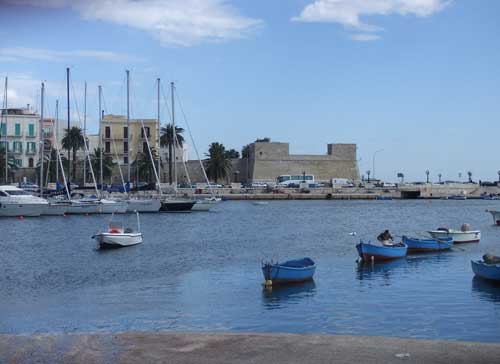About Bari
Bari is a big port city on the Adriatic coast; the capital of the Italian region of Puglia. It’s not a major tourist destination, but it does have an airport with budget flights from the UK, and as well as having a few sights of interest it is well-placed for exploring this attractive part of Italy. Bari doesn’t have a great reputation within Italy (you’ll be warned to hold your valuables tightly), but it is actually a decent place to spend a night or two before moving on to Puglia’s greater tourist attractions.
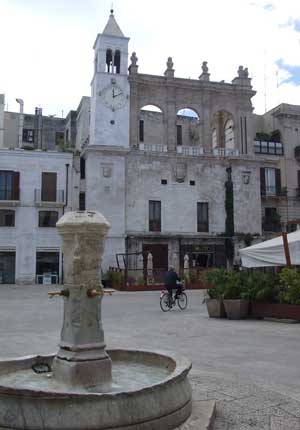
Things to see in Bari
Bari offers about a day’s worth of sightseeing – that is, if you want to explore thoroughly, enjoy a long lunch and visit the local art gallery. If you have less time, you’ll find that you can see Vecchia Bari – Old Bari – and the town’s highlights in just a couple of hours. The interesting bits of town can all be visited on foot, though if you get bored of trekking through the newer car-filled streets you could catch one of the local buses.
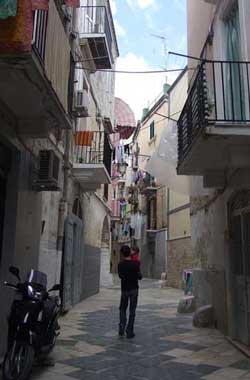
Bari’s historic nucleus is on a headland reaching into the Adriatic Sea. This area has been built on for millennia, but most of the archaeology is buried under the cluster of narrow lanes which make up Vecchia Bari. This part of Bari has a very doubtful reputation. The quarter is famous for being confusing and visitors are almost certainly going to lose their sense of direction. Petty crime is traditionally a problem here, and most guidebooks will warn you not to venture into the district after dark. It is however, the main tourist destination; we visited in the daytime and found the area much less slum-like than expected. The historical lanes were mostly smart and cleaned up. Local people live their lives almost communally, with doors open, women making pasta in the doorways and lots of comings and goings. It is obviously an area with a tight-knit community, perhaps living by their own rules. Two urban police officers, looking hopelessly at a melee of illegally-parked cars, warned us to be careful and hold our bags securely in front of us. We didn’t actually witness any crime or feel threatened, though, and the headland is so small that you can’t get lost for long.
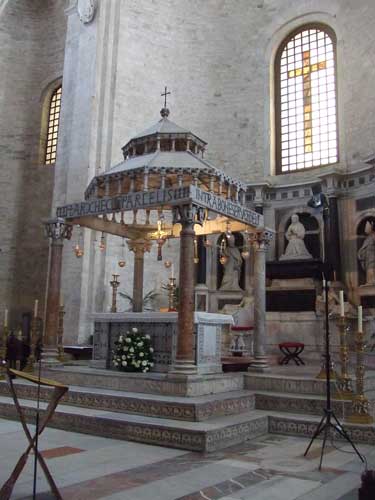
Between the heart of the Old Town and the sea is Bari’s most famous church, the eleventh-century Romanesque Basilica di San Nicola. It is dedicated to St. Nicholas, also known as Santa Claus, and was specially built to house his remains, which still lie in the crypt. This is an important religious destination, and not just for Catholics: there is a chapel in the crypt dedicated to Orthodox pilgrims. The saint’s body is supposed to exude a kind of holy oil and you can actually buy bottles of this remarkable liquid in the church shop next door. In the main part of the church are several notable sights, including an elaborate stone canopy over the altar and a marble bishop’s throne, known as the Cattedra di Elia, dating to the eleventh or twelfth century, which features straining, grimacing little men supporting the seat. Make sure you tour the exterior of the church to see the carved stone doorways.
The lanes of Vecchia Bari nearest to the church are the most touristy, with a line of little souvenir shops. On the other side of the church is a pleasant walkway along the old town walls with views over a road to the sea: this is a nice stroll if the narrow lanes are making you feel claustrophobic.
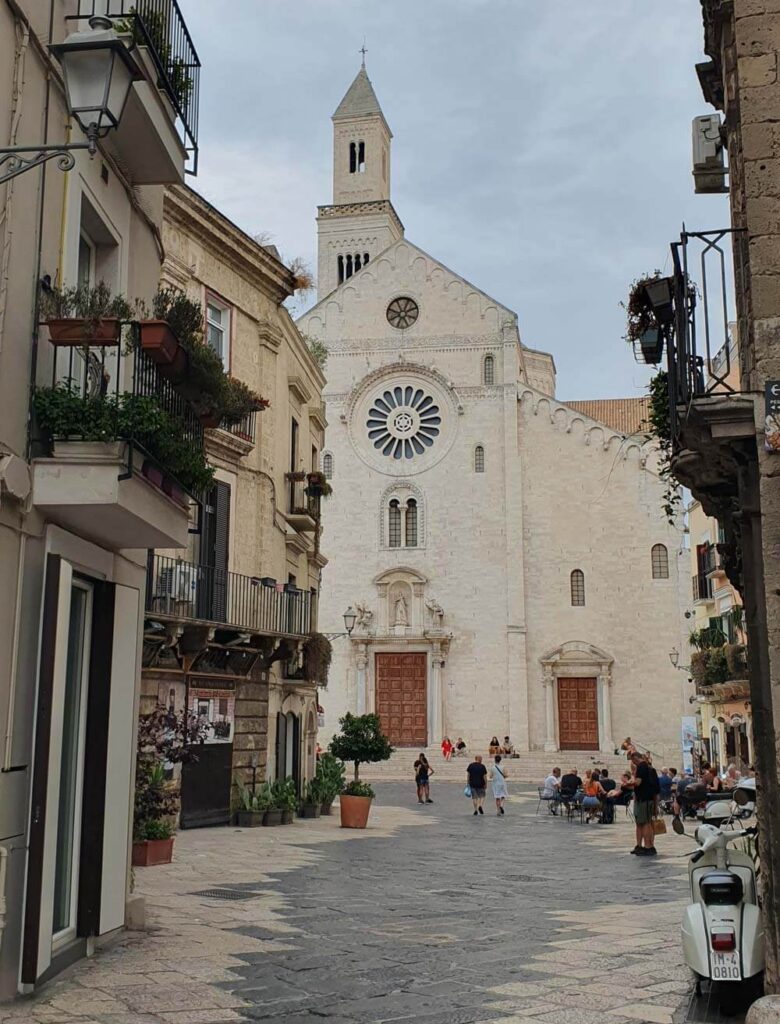
Bari’s other great church is the Cattedrale di San Sabino. This – and not the Basilica di San Nicola – is Bari’s cathedral. It is another massive building in the Romanesque style, dating to the late twelfth century. Close by is Bari’s castle, the Castello Svevo (‘Swabian Castle’), an imposing fortress by the sea which is open to the public. Dotted through the alleys of the Old Town are many other churches, chapels and ruins (generally closed): there are enough sights to merit a short exploration.
On the neck of the headland, and safely out of the lanes of ill repute, are a couple of pleasant interlocking public squares, Piazza del Ferrarese and Piazza Mercantile. This is a good place to stop for lunch or a drink, with a choice of restaurants and cafes with outside tables. The squares are elegant and are historic hubs of the town. The small column protected by a very worn-down lion is called the Colonna della Giustizia: debtors were reputedly tied and flogged here.
Heading inland you cross a busy street to the new town. This ‘new’ town mostly consists of wide nineteenth-century streets busy with traffic. The most pleasant thoroughfare – largely because it has been pedestrianised – is Via Sparano, a high street lined with shops including big high-street brands. It is worth heading out to the seafront to the east of town, by the old port, the Porto Vecchio. Here in the mornings you can see fishermen landing in small wooden boats with their catch – and then selling it directly on the waterfront.
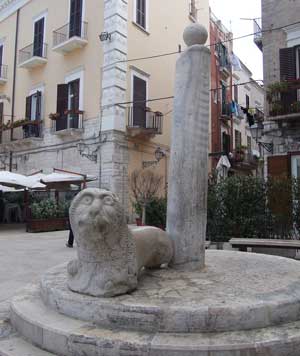
Bari’s town art gallery is the Pinacoteca Provinciale ‘Corrado Giaquinto,’ located on the seafront at Lungomare Nazario Sauro, 27. It exhibits paintings and sculptures from the eleventh to the nineteenth century, including works by Luca Giordano and Giovanni Bellini. Bari also has an archaeological museum, but at the time of writing it is closed awaiting completion of new premises in the Old Town, in the Monastero Santa Scolastica. Until it re-opens a limited number of exhibits are on display in the archaeological HQ at Palazzo Simi on Strada Lamberti (Old Town). This is an interesting building with several layers of history to be seen thanks to excavations.
If you have the time in Bari you may be interested in attending a football match at Bari’s futuristic stadium, designed by Renzo Piano for the 1990 World Cup. It’s called the Stadio San Nicola and is just outside town in the direction of Bitritto. Another alternative Bari activity is to spend time on the beach (although you will find better beaches elsewhere in Puglia). There’s a public beach on Lungomare Perotti.
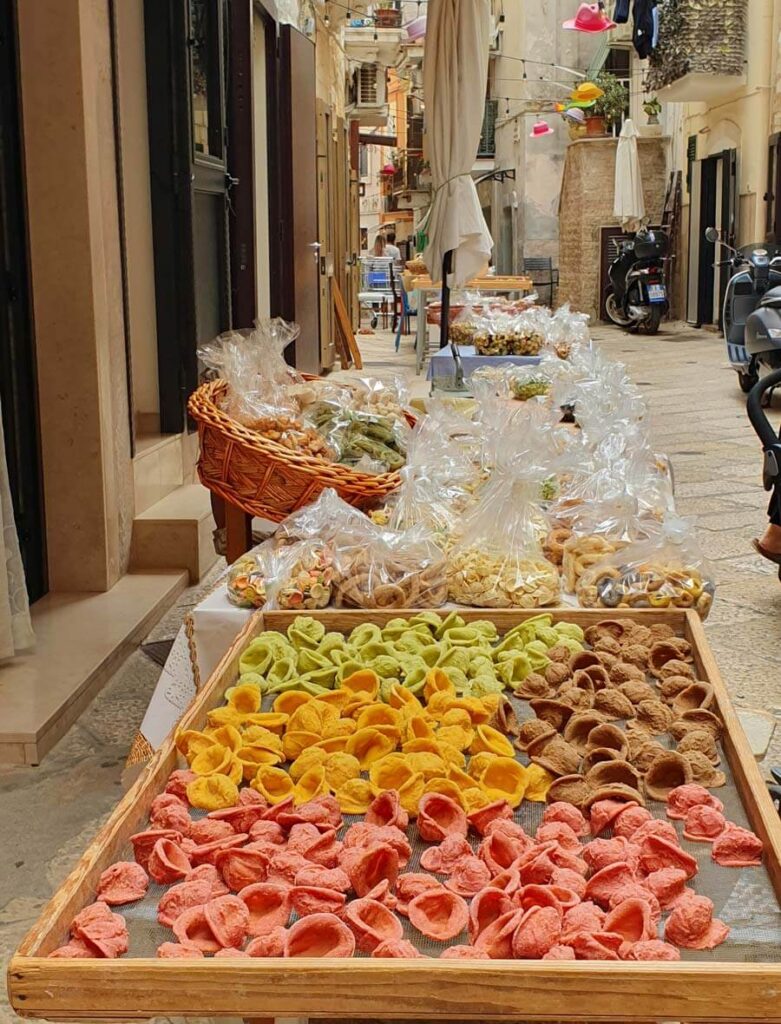
Bari food, drink and practicalities
There are a couple of tourist information offices near the railway station in Bari, and while staff may not be able to provide much English-language help, they should have a stack of maps and bilingual leaflets about the town and surrounding province. When you’re planning your day, bear in mind that shops and churches – including the two major tourist destination churches – close in the middle of the day for several hours.
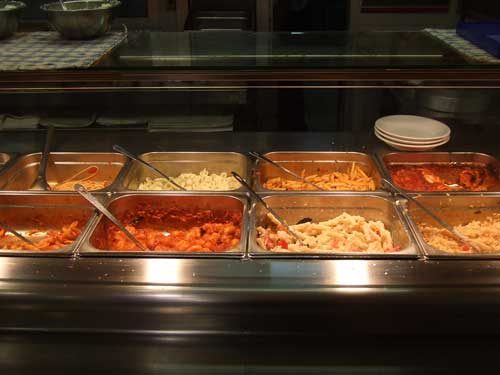
Our top food tip for Bari, recommended to us by an Italian-in-the-know, is a cheap and unpretentious eating place in the newer part of town. El Pedro (Via Piccinni, 152) is a self-service canteen/restaurant where you collect a tray, and file past mouthwatering selections of pasta (3 per portion), contorni, desserts, salads and more. The staff are efficient and ready to help out confused foreigners; we ate extremely well for around 12 euros for two including a little wine. For a more traditional, though touristy, restaurant meal, try the pleasant squares at the edge of the Old Town, Piazza Mercantile and Piazza del Ferrarese. Around the railway station there are the usual fast-food type eateries. In addition, there are various restaurants scattered around town, and the usual Italian array of cafes where you can fill up with a hot drink, croissant or sandwich.
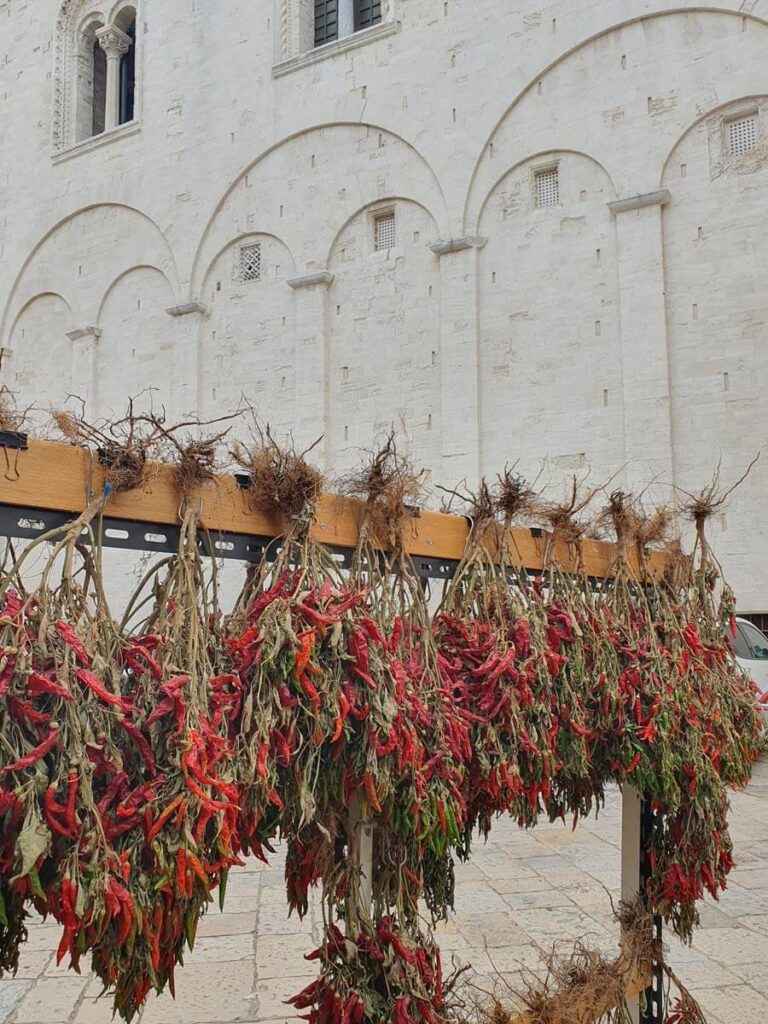
Around Bari
Outside the centre, most of Bari’s outskirts are appallingly ugly: unpleasant tower blocks, heavy industry and wasteland bizarrely dotted with allotments. Once you’re beyond the sprawl though, the countryside is green and attractive, covered with olive trees. There are some interesting day trips which can be made from Bari using public transport; though we’d recommend you move on to a more attractive location after a day or two, rather than basing yourself in the city.
Bari is an important transport hub. As well as mainline FS railway services, it is also the terminus for several private railway lines which connect some of the area’s inland towns, including the cave city of Matera (in the neighbouring region, Basilicata) and the trullo town of Alberobello. By catching a train to Andria and then a bus (or driving) you can visit Castel del Monte, Frederick II’s famous castle on a hill which is now a UNESCO site. Another short train ride away is Trani, which is a very attractive seaside town with a fishing harbour and a cathedral poised above the sea. Beyond Trani is Barletta, another historic coastal town, which can be combined in a day trip with Castel del Monte and/or Trani.
Bari travel
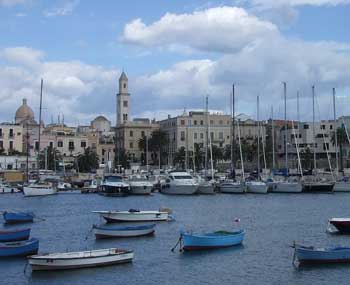
Bari Airport (Bari Palese) is just outside town, with two different bus services running from the airport to Piazza Aldo Moro, outside the railway station. More details of the airport and transport links can be found on our Bari Airport page.
Several different railway lines terminate in Bari, and there are three different central railway stations all clustered together at Piazza Aldo Moro. The mainline railway services run by the FS, Italy’s national rail network, use the main station, Bari Centrale, and they connect Bari with other Italian destinations. Beyond the FS platforms are a couple of platforms used by the Ferrovie Sud Est (FSE). FSE operate little trains which wind through inland Puglia, stopping at useful tourist destinations like Alberobello and Martina Franca. There is a separate ticket office on the platform for these trains – ask which train to get on, as there’s not much signage.
Alongside the main railway station are two other small stations, with separate entrances and ticket offices. The first of these is operated by the Ferrovie Nord Barese, with trains taking an inland route north-west to Barletta via Ruvo di Puglia and Andria (for Castel del Monte). Next to this station, and up a flight of steps, is the terminus for Ferrovie Appulo Lucane. This is where you catch trains heading to the region of Basilicata, stopping at Matera. The ticket office is on the ground floor below the platforms. Whichever train service you are catching, remember to stamp your tickets in the machines provided before you board your train. Note that the private railway lines generally don’t operate on Sundays and public holidays – some are replaced by bus services, but do check the latest timetables before you plan your travel (see our links panel on the right).
Within Bari there are urban bus services operated by a company called AMTAB, but if you’re staying in the city centre you’ll find you can explore the bits of Bari worth seeing on foot.
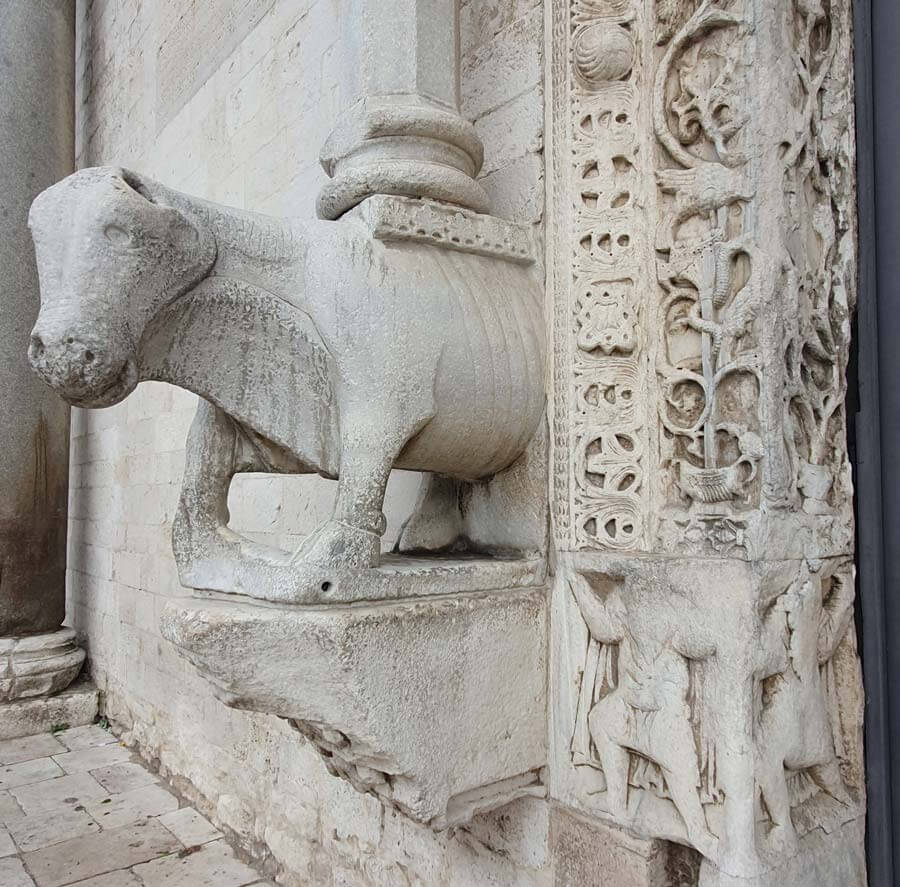
Bari accommodation
Bari is not a great city for hotels. There aren’t that many, and those there are tend to be over-priced and mediocre. Still, as the rest of Puglia develops its tourist hospitality, maybe Bari will begin to catch up. In any case, we wouldn’t really recommend staying more than one or two nights – see the local sights, perhaps fit in a day trip, and then move on to see more of the region.
> Bari accommodation
> More Puglia hotels
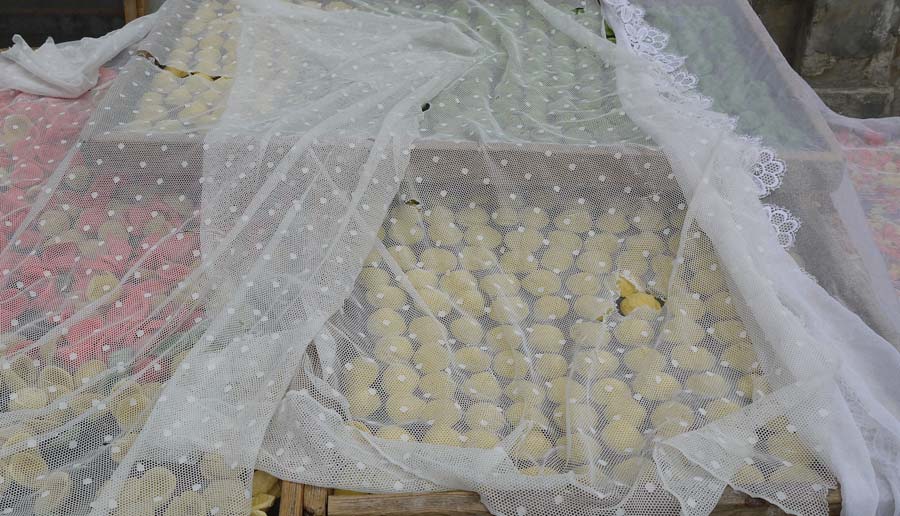
Useful external links
Ferrotramviaria – Ferrovie Nord Barese (timetables are under orari)
AMTAB urban buses
